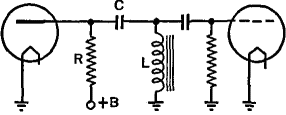| Basic Radio is a free introductory textbook on electronics based on tubes. See the editorial for more information.... |

|

Home  Amplifiers Amplifiers  Audio-Frequency Amplifiers Audio-Frequency Amplifiers  Impedance-Coupled Amplifiers Impedance-Coupled Amplifiers |
||||






|
||||
|
Impedance-Coupled AmplifiersAuthor: J.B. Hoag The principle of the impedance-coupled amplifier was discussed previously. The addition of the power supplies, with their attendant filtering and decoupling circuits, follows the same lines of reasoning as for the R-C coupled amplifiers.
The blocking condenser C can be chosen so that its reactance is numerically equal to that of the coil L for a given frequency. Parallel resonance then occurs in the circuit RCL. The voltages which develop across L at the resonant frequency are comparatively large. If L = 125 h. and C = 0.05 μfd., then fr = 60 cycles. Then the gain of the amplifier at the low frequency end will be greatly augmented. In fact, the frequency whereat the resonant character of the RCL circuit is developed can be chosen at will, thus increasing the gain at low, at intermediate, or at high frequencies. If R is kept to a low value, the resonant peak will be sharp, and vice versa. Thus the frequency-response curve of this type of amplifier can be made to have a wide variety of shapes. In conclusion, we may say that impedance-coupled amplifiers give somewhat greater gain per stage than do R-C coupled amplifiers, they do not require as high a voltage for the B supply, and they do not (in general) have as constant an amplification at different frequencies.
|
||||
Home  Amplifiers Amplifiers  Audio-Frequency Amplifiers Audio-Frequency Amplifiers  Impedance-Coupled Amplifiers Impedance-Coupled Amplifiers |
||||
Last Update: 2010-11-27


